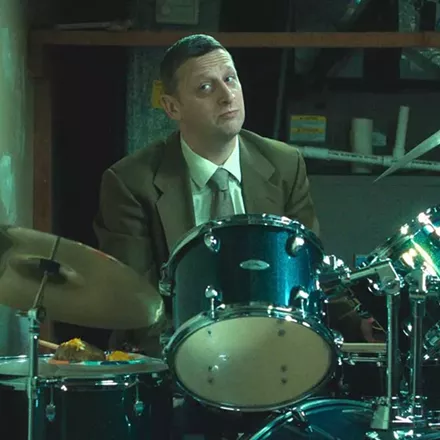Height of Fashion
Mrs. Harris Goes to Paris is a Cinderella story elevated by a Jenny Beavan's costume-designing magic.
By Scott Renshaw @scottrenshawAppearing in the middle of the summer movie season, Mrs. Harris Goes to Paris is exactly the kind of unassuming, lighthearted fare that seems destined to be overwhelmed by the higher-profile offerings built entirely on the work of "below the line" craftspeople—those folks who work behind the scenes on movie productions, generally unknown to the public. In the 21st century, many of those people are working at computers on visual effects, yet there are plenty of jobs that have existed since the dawn of cinema and still somehow go underappreciated. And in the case of Mrs. Harris Goes to Paris—a movie with a plot built around the magical allure of a beautiful piece of clothing—it seems fitting to reserve a particular degree of praise for costume designer Jenny Beavan.
Mind you, it's not as though Beavan has gone completely unheralded over the course of her 40-plus year career. She's got three Oscars for her trophy case, including one just last year for Cruella, so it's fair to say she's acknowledged as one of the best there is at what she does. But in taking on the third filmed adaptation of Paul Gallico's 1958 novel, director Anthony Fabian had the good sense to understand that there are circumstances that demand getting the best. As charming as Mrs. Harris Goes to Paris is, it simply doesn't work at all without the distinctive flair that Beavan can bring.
Set in 1957 London, it's the story of a cleaning woman named Ada Harris (Lesley Manville), who has only just found out that the hope she's been clinging to for the life of her MIA husband for more than a decade after the end of the war has been for naught. At the home of one of her wealthy employers, she spots an expensive Christian Dior gown, and becomes obsessed with the idea of scraping together every possible penny to get one for herself. When she eventually finds herself in Paris, however, she finds that the road to having her dream come true is a bit more complicated than she expected.
There's a familiar fish-out-of-water component to what follows, as the good-natured, working-class Mrs. Harris mixes and mingles with the snooty employees of Dior—including the officious director (Isabelle Huppert)—and more well-meaning new friends like a kindly marquis (Lambert Wilson), the Dior head of accounts (Lucas Bravo) and a fashion model with an affinity for Sartre (Alba Baptista). Manville provides an appealing presence at the center of it all, in a narrative that somehow dodges some of the most obvious overly-twinkly romanticism through a choice as simple as finding Mrs. Harris in Paris during the middle of a garbage strike, so that even a walk along the Seine is accompanied by piles of trash.
This is, however, largely about the way couture suggests a different kind of life for Mrs. Harris, so the dresses she's swooning over need to be the real thing. Beavan comes through like a champ, evoking the classic designs of 1950s Dior in a centerpiece sequence that finds Mrs. Harris unexpectedly attending the premiere of Dior's new couture line. Fabian draws out the sequence by letting his camera lovingly caress every creation that appears before Mrs. Harris, and pulling out the old dolly-zoom for Mrs. Harris drifting into a kind of trance at the vision of her favorite design. The counterpoint of the simpler look for Mrs. Harris's own everyday duds—prints that occasionally seem to blend in with her wallpaper, all but rendering her invisible—provides the punctuation for the aspirational attraction of high fashion.
The interesting thing about the story of Mrs. Harris Goes to Paris is that it's an odd sort of Cinderella story in which the protagonist's character arc is trying not to see herself exclusively as the "fairy godmother"—as another character literally calls her at one point—but as someone who deserves her own chance to go to the ball. There's something unique about emphasizing the value of deciding you can care about what you want for yourself, and not just about doing for others, and that making the choice to find yourself beautiful is worthy of admiration. It's a lot easier to make that kind of Cinderella story work when the fairy godmother behind the scenes is someone like Jenny Beavan, whose working of magic doesn't come from a wand, but from real, wonderful work.
More by Scott Renshaw
-
Writer of the Lost Oligarch
The Phoenician Scheme gets both silly and serious about what makes rich dickheads tick.
- Jun 4, 2025
-
Film Reviews: New Releases for May 30
Karate Kid Legends, Bring Her Back, Jane Austen Wrecked My Life, Bad Shabbos, Tornado
- May 29, 2025
-
JANE AUSTEN WRECKED MY LIFE, BRING HER BACK, June 2025 Special Screenings
Two new releases, plus SLFS Summer Showdown, Wild & Scenic Festival and more.
- May 28, 2025
- More »
Latest in Film Reviews
Readers also liked…
-
Sundance 2025 wrap-up plus February special screenings
Uncertainty about the future location shifts focus away from the movies
- Feb 5, 2025










